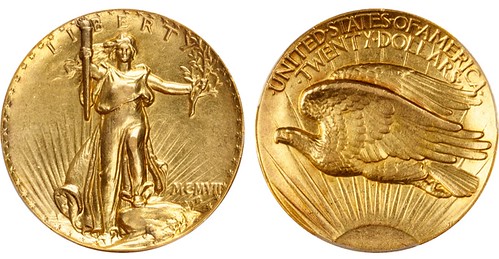
PREV ARTICLE
NEXT ARTICLE
FULL ISSUE
PREV FULL ISSUE
BONHAMS TO OFFER EXPERIMENTAL ULTRA HIGH RELIEF $20Last this month Bonham's in New York will auction one of the first four experimental Ultra High Relief $20 coins. Here's an
article based on their press release. -Editor
 An extremely rare 1907 Saint-Gaudens Ultra High Relief $20 featuring an early production Sans Serif lettered edge will go under the hammer on December 16, 2014 (est. $1,250,000 - $1,500,000) at the Coins and Medals auction. The collar’s Sans Serif font that was used on the edge of the earliest Ultra High Reliefs distinguishes this coin as one of the first struck. It is also known as the Type of 1906, and only one other example is known with this edge feature. Another interesting fact about the edge is that the collar impresses the lettering in an inverted fashion. Between February 7th and 14th in 1907, the first four experimental Ultra High Relief $20 coins, including this coin, were struck at the Mint in Philadelphia. Paul Song, director of the Los Angeles based department, states, “This coin is an old friend of sorts. Earlier in my career in 1992, I discovered this coin variety for the first time at an East Coast estate and sold it at auction for $143,000. Almost 25 years later, I am pleased to place it on auction again. Close examination of the edge revealed lettering without serifs—the same style that was used in 1906 to create the Judd-1992 $20 gold pattern. No one had ever thought to look at the edge or the collar of an Ultra High Relief before. " It is almost certain that this is the first Ultra High Relief ever struck. The light rubbing on the surfaces could easily be the result of this coin being personally examined by Mint officials and even by Theodore Roosevelt himself, just after striking. The design and inspiration of the 1907 Ultra High Relief and later standard High Relief are legendary, and this particular coin design has been widely touted as the most beautiful coin ever produced by the United States Mint—a testament which is certainly reinforced by the fact that this basic design is still in use by the United States Mint for its coinage today, over a century later. I asked researcher Roger Burdette about this. He writes: I see no evidence presented by Bonhams to support the above statement. Without supporting documentation the above is nothing but speculation. Given the brief description, all that can be said is the coin was likely one of the first group struck. I have to agree with Roger. Without a pedigree chain it's impossible to trace whose hands this piece passed through. Still a
significant piece and a great rarity of U.S. numismatics. -Editor
To read the complete article, see:
Wayne Homren, Editor The Numismatic Bibliomania Society is a non-profit organization promoting numismatic literature. See our web site at coinbooks.org. To submit items for publication in The E-Sylum, write to the Editor at this address: whomren@gmail.com To subscribe go to: https://my.binhost.com/lists/listinfo/esylum All Rights Reserved. NBS Home Page Contact the NBS webmaster 
|